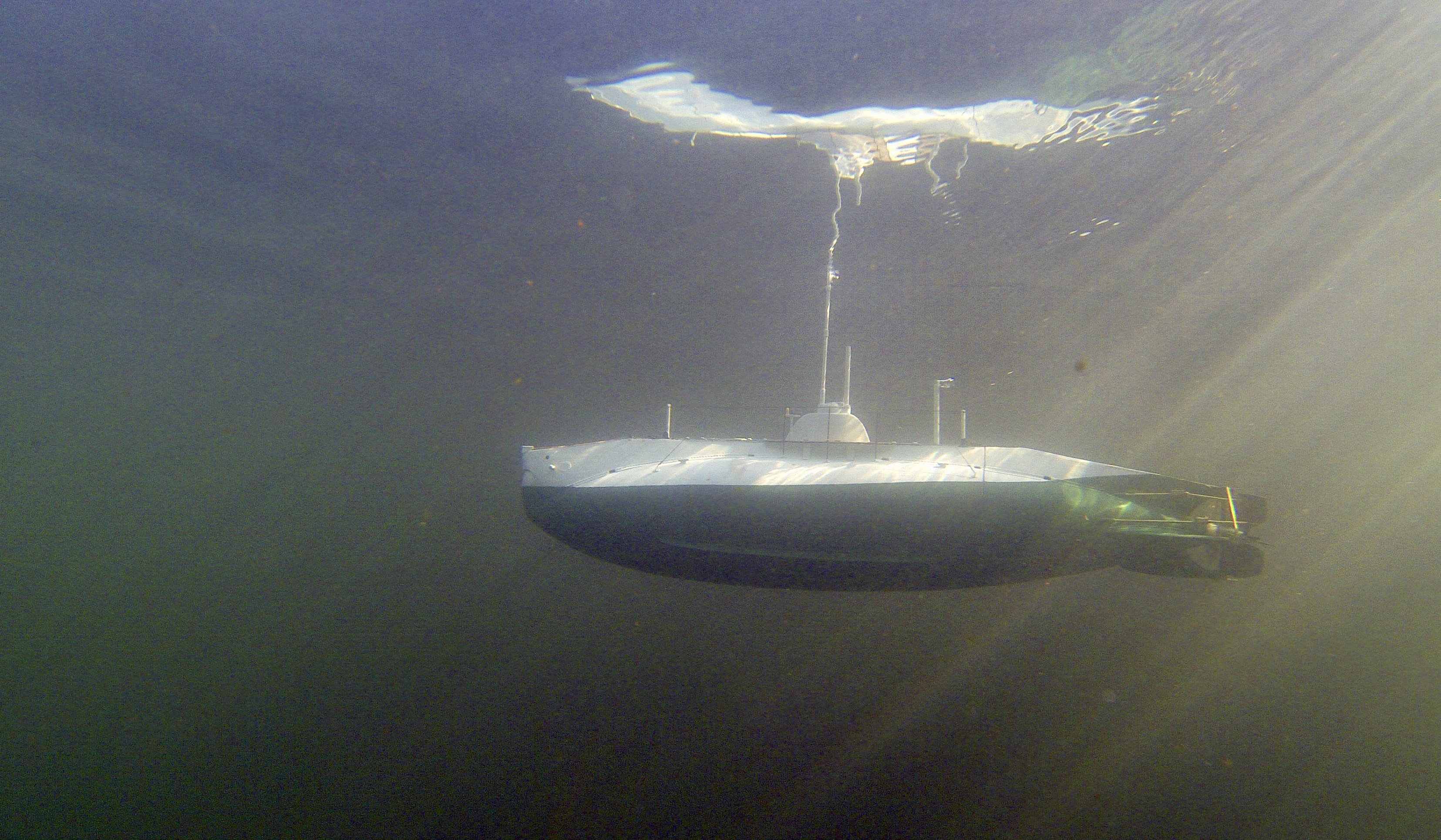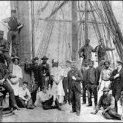Supplies of the Ship Modeler's Handbook are running out. Get your copy NOW before they are gone! Click on photo to order.
×
-
Posts
213 -
Joined
-
Last visited
Reputation Activity
-
 FreekS got a reaction from yvesvidal in HrMs O-13 by FreekS - 1:50 - RADIO - 1931-1940 - Last Dutch Sub “on eternal patrol”
FreekS got a reaction from yvesvidal in HrMs O-13 by FreekS - 1:50 - RADIO - 1931-1940 - Last Dutch Sub “on eternal patrol”
Thanks for your interests - the boat has at least 14 tanks, with the main ballast tanks in the saddles. Well visible on the frame-plan.
yes lots of technical challenges - these 1931 boat was rather small - and so I will refrain from working torpedotubes! But I’m going to ensure I have spare power and signal wires going out of the water tight compartment so I can later consider moving periscopes and navigation lights.
-
 FreekS got a reaction from Ian_Grant in HrMs O-13 by FreekS - 1:50 - RADIO - 1931-1940 - Last Dutch Sub “on eternal patrol”
FreekS got a reaction from Ian_Grant in HrMs O-13 by FreekS - 1:50 - RADIO - 1931-1940 - Last Dutch Sub “on eternal patrol”
Reached a milestone in that the planking of the hull is complete!
I cut my planks myself out of pine, they are 4mm wide and 2 mm thick and were cut from 2m by 5cm by 4mm planks. Just needed to avoid the knots in the wood.
the keel of the boat has a thicker area, probably for ballast, as these boats suffered from instability, which is why a deck gun was not included in the class. The keel was not, however, detachable which was common in even older subs.
next step is rough sanding, followed by a first coat of epoxy before splitting the boat as described in a previous post to have access to the inside.
-
 FreekS got a reaction from Harvey Golden in HrMs O-13 by FreekS - 1:50 - RADIO - 1931-1940 - Last Dutch Sub “on eternal patrol”
FreekS got a reaction from Harvey Golden in HrMs O-13 by FreekS - 1:50 - RADIO - 1931-1940 - Last Dutch Sub “on eternal patrol”
Reached a milestone in that the planking of the hull is complete!
I cut my planks myself out of pine, they are 4mm wide and 2 mm thick and were cut from 2m by 5cm by 4mm planks. Just needed to avoid the knots in the wood.
the keel of the boat has a thicker area, probably for ballast, as these boats suffered from instability, which is why a deck gun was not included in the class. The keel was not, however, detachable which was common in even older subs.
next step is rough sanding, followed by a first coat of epoxy before splitting the boat as described in a previous post to have access to the inside.
-
 FreekS reacted to mikegr in Type 45 Destroyer by mikegr - FINISHED - 1/700
FreekS reacted to mikegr in Type 45 Destroyer by mikegr - FINISHED - 1/700
I will build the cousin of my previous work - Horizon class, the type 45 Destroyer.
-
 FreekS got a reaction from Canute in HrMs O-13 by FreekS - 1:50 - RADIO - 1931-1940 - Last Dutch Sub “on eternal patrol”
FreekS got a reaction from Canute in HrMs O-13 by FreekS - 1:50 - RADIO - 1931-1940 - Last Dutch Sub “on eternal patrol”
Thanks for your interests - the boat has at least 14 tanks, with the main ballast tanks in the saddles. Well visible on the frame-plan.
yes lots of technical challenges - these 1931 boat was rather small - and so I will refrain from working torpedotubes! But I’m going to ensure I have spare power and signal wires going out of the water tight compartment so I can later consider moving periscopes and navigation lights.
-
 FreekS got a reaction from Rik Thistle in HrMs O-13 by FreekS - 1:50 - RADIO - 1931-1940 - Last Dutch Sub “on eternal patrol”
FreekS got a reaction from Rik Thistle in HrMs O-13 by FreekS - 1:50 - RADIO - 1931-1940 - Last Dutch Sub “on eternal patrol”
I’ve sort of worked out how the front diveplanes and the rear rudder assembly need to work. They will still be a lot of work, but I can get on with planking. To have access to the front and rear planes mechanisms, I’ve decided to split the boat both horizontally and vertically. Vertically with a bayonet which will open the water tight compartment, and horizontally for maintenance. Horizontally the boat will split along the “drainage line” where the bottom hull meets the deck section.
That is the top plank visible in the photo that overlaps the plank below. Those are not glued together so once planking is complete, I will cut the frames along that line.
in the stern, a solid block of wood is mounted that will hold the pushrods for the rudder and diveplanes.
-
 FreekS got a reaction from GrandpaPhil in HrMs O-13 by FreekS - 1:50 - RADIO - 1931-1940 - Last Dutch Sub “on eternal patrol”
FreekS got a reaction from GrandpaPhil in HrMs O-13 by FreekS - 1:50 - RADIO - 1931-1940 - Last Dutch Sub “on eternal patrol”
I’ve sort of worked out how the front diveplanes and the rear rudder assembly need to work. They will still be a lot of work, but I can get on with planking. To have access to the front and rear planes mechanisms, I’ve decided to split the boat both horizontally and vertically. Vertically with a bayonet which will open the water tight compartment, and horizontally for maintenance. Horizontally the boat will split along the “drainage line” where the bottom hull meets the deck section.
That is the top plank visible in the photo that overlaps the plank below. Those are not glued together so once planking is complete, I will cut the frames along that line.
in the stern, a solid block of wood is mounted that will hold the pushrods for the rudder and diveplanes.
-
 FreekS got a reaction from KeithAug in HrMs O-13 by FreekS - 1:50 - RADIO - 1931-1940 - Last Dutch Sub “on eternal patrol”
FreekS got a reaction from KeithAug in HrMs O-13 by FreekS - 1:50 - RADIO - 1931-1940 - Last Dutch Sub “on eternal patrol”
Thanks for your interests - the boat has at least 14 tanks, with the main ballast tanks in the saddles. Well visible on the frame-plan.
yes lots of technical challenges - these 1931 boat was rather small - and so I will refrain from working torpedotubes! But I’m going to ensure I have spare power and signal wires going out of the water tight compartment so I can later consider moving periscopes and navigation lights.
-
 FreekS got a reaction from Roger Pellett in HrMs O-13 by FreekS - 1:50 - RADIO - 1931-1940 - Last Dutch Sub “on eternal patrol”
FreekS got a reaction from Roger Pellett in HrMs O-13 by FreekS - 1:50 - RADIO - 1931-1940 - Last Dutch Sub “on eternal patrol”
Thanks for your interests - the boat has at least 14 tanks, with the main ballast tanks in the saddles. Well visible on the frame-plan.
yes lots of technical challenges - these 1931 boat was rather small - and so I will refrain from working torpedotubes! But I’m going to ensure I have spare power and signal wires going out of the water tight compartment so I can later consider moving periscopes and navigation lights.
-
 FreekS got a reaction from GrandpaPhil in HrMs O-13 by FreekS - 1:50 - RADIO - 1931-1940 - Last Dutch Sub “on eternal patrol”
FreekS got a reaction from GrandpaPhil in HrMs O-13 by FreekS - 1:50 - RADIO - 1931-1940 - Last Dutch Sub “on eternal patrol”
Thanks for your interests - the boat has at least 14 tanks, with the main ballast tanks in the saddles. Well visible on the frame-plan.
yes lots of technical challenges - these 1931 boat was rather small - and so I will refrain from working torpedotubes! But I’m going to ensure I have spare power and signal wires going out of the water tight compartment so I can later consider moving periscopes and navigation lights.
-
 FreekS got a reaction from Canute in HrMs O-13 by FreekS - 1:50 - RADIO - 1931-1940 - Last Dutch Sub “on eternal patrol”
FreekS got a reaction from Canute in HrMs O-13 by FreekS - 1:50 - RADIO - 1931-1940 - Last Dutch Sub “on eternal patrol”
I’ve sort of worked out how the front diveplanes and the rear rudder assembly need to work. They will still be a lot of work, but I can get on with planking. To have access to the front and rear planes mechanisms, I’ve decided to split the boat both horizontally and vertically. Vertically with a bayonet which will open the water tight compartment, and horizontally for maintenance. Horizontally the boat will split along the “drainage line” where the bottom hull meets the deck section.
That is the top plank visible in the photo that overlaps the plank below. Those are not glued together so once planking is complete, I will cut the frames along that line.
in the stern, a solid block of wood is mounted that will hold the pushrods for the rudder and diveplanes.
-
 FreekS got a reaction from wefalck in HrMs O-13 by FreekS - 1:50 - RADIO - 1931-1940 - Last Dutch Sub “on eternal patrol”
FreekS got a reaction from wefalck in HrMs O-13 by FreekS - 1:50 - RADIO - 1931-1940 - Last Dutch Sub “on eternal patrol”
Thanks for your interests - the boat has at least 14 tanks, with the main ballast tanks in the saddles. Well visible on the frame-plan.
yes lots of technical challenges - these 1931 boat was rather small - and so I will refrain from working torpedotubes! But I’m going to ensure I have spare power and signal wires going out of the water tight compartment so I can later consider moving periscopes and navigation lights.
-
 FreekS got a reaction from mtaylor in HrMs O-13 by FreekS - 1:50 - RADIO - 1931-1940 - Last Dutch Sub “on eternal patrol”
FreekS got a reaction from mtaylor in HrMs O-13 by FreekS - 1:50 - RADIO - 1931-1940 - Last Dutch Sub “on eternal patrol”
Thanks for your interests - the boat has at least 14 tanks, with the main ballast tanks in the saddles. Well visible on the frame-plan.
yes lots of technical challenges - these 1931 boat was rather small - and so I will refrain from working torpedotubes! But I’m going to ensure I have spare power and signal wires going out of the water tight compartment so I can later consider moving periscopes and navigation lights.
-
 FreekS got a reaction from Javelin in HrMs O-13 by FreekS - 1:50 - RADIO - 1931-1940 - Last Dutch Sub “on eternal patrol”
FreekS got a reaction from Javelin in HrMs O-13 by FreekS - 1:50 - RADIO - 1931-1940 - Last Dutch Sub “on eternal patrol”
I’ve sort of worked out how the front diveplanes and the rear rudder assembly need to work. They will still be a lot of work, but I can get on with planking. To have access to the front and rear planes mechanisms, I’ve decided to split the boat both horizontally and vertically. Vertically with a bayonet which will open the water tight compartment, and horizontally for maintenance. Horizontally the boat will split along the “drainage line” where the bottom hull meets the deck section.
That is the top plank visible in the photo that overlaps the plank below. Those are not glued together so once planking is complete, I will cut the frames along that line.
in the stern, a solid block of wood is mounted that will hold the pushrods for the rudder and diveplanes.
-
 FreekS got a reaction from wefalck in HrMs O-13 by FreekS - 1:50 - RADIO - 1931-1940 - Last Dutch Sub “on eternal patrol”
FreekS got a reaction from wefalck in HrMs O-13 by FreekS - 1:50 - RADIO - 1931-1940 - Last Dutch Sub “on eternal patrol”
I’ve sort of worked out how the front diveplanes and the rear rudder assembly need to work. They will still be a lot of work, but I can get on with planking. To have access to the front and rear planes mechanisms, I’ve decided to split the boat both horizontally and vertically. Vertically with a bayonet which will open the water tight compartment, and horizontally for maintenance. Horizontally the boat will split along the “drainage line” where the bottom hull meets the deck section.
That is the top plank visible in the photo that overlaps the plank below. Those are not glued together so once planking is complete, I will cut the frames along that line.
in the stern, a solid block of wood is mounted that will hold the pushrods for the rudder and diveplanes.
-
 FreekS got a reaction from KeithAug in HrMs O-13 by FreekS - 1:50 - RADIO - 1931-1940 - Last Dutch Sub “on eternal patrol”
FreekS got a reaction from KeithAug in HrMs O-13 by FreekS - 1:50 - RADIO - 1931-1940 - Last Dutch Sub “on eternal patrol”
I finished the sawing of the frames, and placed the half-frames loose on the “keel”. It’s clearly a more difficult shape, with the saddletanks in the middle and a suddenly widening keel below them. I also had to take into account the space for the watertight cylinders and for the prop axes as drilling will be harder once the hull is planked. the two thicker frames is where the hull will be cut to access the insides.
-
 FreekS got a reaction from Rik Thistle in HrMs O-13 by FreekS - 1:50 - RADIO - 1931-1940 - Last Dutch Sub “on eternal patrol”
FreekS got a reaction from Rik Thistle in HrMs O-13 by FreekS - 1:50 - RADIO - 1931-1940 - Last Dutch Sub “on eternal patrol”
I’m just starting this new project. Netherlands started WW2 with 23 submarines, split evenly between Netherlands-based and Dutch East Indies based. Seven of these subs were lost. O-13 first saw action in the Spanish civil war escorting ships, and then escaped from Netherlands to England in May 1040 with many other boats. However, already in June 1940 on her second war patrol in the waters between Norway and Denmark she failed to return. To this day the wreck has not been found, but every few years there are searches with newer equipment. The most likely cause of her loss is being struck by a mine in a (now known) minefield along her route, but also attacks by German aircraft and a collision with a Polish sub are remote possibilities.
This model will be radio controlled, and the boat will be in-between my Holland-class O-1 (the first sub in the Dutch navy) and the larger K-XVIII which fought the Japanese in Asian waters. Both those models still sail regularly and well.
O-13 was part of a class of 4, at 60 meters in length and with underwater displacement of 750 tons she was suitable for coastal waters, but also travelled to the Dutch islands in the Caribbean and the waters around Gibraltar. She had 4 torpedo tubes in the bow, one in the stern, and two 40mm guns retracting into buns. No deck gun was installed and some of the 40mm guns were removed as the class had significant stability issues.
I have the original build plans (which can be downloaded freely from the Dutch national archives), but photos, especially dock-photos are relatively rare.
I plan to build a traditional plank on frame wooden hull, impregnated with epoxy and coated with woven glass. Inside will be a watertight compartment made up of several connected tubes to house the technology to fill and empty the dive tank, and to control the two props, rudder and diveplanes. I hope to include running lights in the wet area and also attempt to functionalisme the folding forward dive planes visible in the picture. Due to space constraints I will not aim to make moving periscopes and functioning torpedo’s for this model. In the end the model will be 120cm long, 13cm wide at its widest point, likely weigh 3-5kg, and use tubing of 50 and 75 mm diameter as water tight compartment.
So far, I’ve been doing rough planning of the location of components, closure means, and rough calculations of the required size of the dive tank to achieve a realistic waterline. I’ve also started to convert the build plans to individual frame drawings (taking into account the thickness of the hull planks (2mm) and the need to mount the frames on a build plank). Needless to say - this will not be a quick build!
-
 FreekS got a reaction from mtaylor in HrMs O-13 by FreekS - 1:50 - RADIO - 1931-1940 - Last Dutch Sub “on eternal patrol”
FreekS got a reaction from mtaylor in HrMs O-13 by FreekS - 1:50 - RADIO - 1931-1940 - Last Dutch Sub “on eternal patrol”
I’ve sort of worked out how the front diveplanes and the rear rudder assembly need to work. They will still be a lot of work, but I can get on with planking. To have access to the front and rear planes mechanisms, I’ve decided to split the boat both horizontally and vertically. Vertically with a bayonet which will open the water tight compartment, and horizontally for maintenance. Horizontally the boat will split along the “drainage line” where the bottom hull meets the deck section.
That is the top plank visible in the photo that overlaps the plank below. Those are not glued together so once planking is complete, I will cut the frames along that line.
in the stern, a solid block of wood is mounted that will hold the pushrods for the rudder and diveplanes.
-
 FreekS got a reaction from Harvey Golden in HrMs O-13 by FreekS - 1:50 - RADIO - 1931-1940 - Last Dutch Sub “on eternal patrol”
FreekS got a reaction from Harvey Golden in HrMs O-13 by FreekS - 1:50 - RADIO - 1931-1940 - Last Dutch Sub “on eternal patrol”
All frames now glued to the keel, and I inserted small sticks between the frames which gives the hull rigidity.
Before planking, I have to assure myself I can install the rudder/diveplanes assembly in the stern, and the bow planes in the bow. The boat is so narrow at this points (around 2cm), that I have to have a clear idea of the controls on the planes and rudders before closing the hull!!
started with the bow planes, which as the photo on the 1st post shows, rotate upwards and then fold back when the sub is on the surface. I made a brass assembly where two cogwheels control the dive angle and the vertical rotation, and then a pushrod can fold the planes against the hull.
it sort of works, but I have a long list of modifications before I can make a true prototype. And yes, the planes themselves will get shaped!
-
 FreekS got a reaction from yvesvidal in HrMs O-13 by FreekS - 1:50 - RADIO - 1931-1940 - Last Dutch Sub “on eternal patrol”
FreekS got a reaction from yvesvidal in HrMs O-13 by FreekS - 1:50 - RADIO - 1931-1940 - Last Dutch Sub “on eternal patrol”
I finished the sawing of the frames, and placed the half-frames loose on the “keel”. It’s clearly a more difficult shape, with the saddletanks in the middle and a suddenly widening keel below them. I also had to take into account the space for the watertight cylinders and for the prop axes as drilling will be harder once the hull is planked. the two thicker frames is where the hull will be cut to access the insides.
-
 FreekS got a reaction from yvesvidal in HrMs O-13 by FreekS - 1:50 - RADIO - 1931-1940 - Last Dutch Sub “on eternal patrol”
FreekS got a reaction from yvesvidal in HrMs O-13 by FreekS - 1:50 - RADIO - 1931-1940 - Last Dutch Sub “on eternal patrol”
Started converting the concept drawing into a 1:50 plan. I’ve not made too many plank on frame models, normally I’d mount the frames on a build plank upside down. With this submarine planking has to go all the way around, so a build plank seems not too useful.
I therefore cut a “keel/deck support plank” (no idea if there is a name for this) and will glue the frames to this plank.
the keel is 8mm thick and the shown frame 44 also, as that is where the hull will be cut later to have access to the inside, so I need some strength in that area. I’ll likely double that frame at least. . .
this was also sort of a test frame if I can cut the frame from the print, transfer it to both halves of the wood and saw it out accurately. Took quite some time - maybe I’ll try gluing the paper to the wood first.
The other frames will be 4mm thick and after all frames are mounted I will connect them first with inserted short wood pieces to end up with a rigid (and hopefully straight) hull. I did that once before and it worked but for a shorter and simpler hull
(so this was the basis of my Holland class sub, with much simpler circular frames)
-
 FreekS got a reaction from KeithAug in HrMs O-13 by FreekS - 1:50 - RADIO - 1931-1940 - Last Dutch Sub “on eternal patrol”
FreekS got a reaction from KeithAug in HrMs O-13 by FreekS - 1:50 - RADIO - 1931-1940 - Last Dutch Sub “on eternal patrol”
I’m just starting this new project. Netherlands started WW2 with 23 submarines, split evenly between Netherlands-based and Dutch East Indies based. Seven of these subs were lost. O-13 first saw action in the Spanish civil war escorting ships, and then escaped from Netherlands to England in May 1040 with many other boats. However, already in June 1940 on her second war patrol in the waters between Norway and Denmark she failed to return. To this day the wreck has not been found, but every few years there are searches with newer equipment. The most likely cause of her loss is being struck by a mine in a (now known) minefield along her route, but also attacks by German aircraft and a collision with a Polish sub are remote possibilities.
This model will be radio controlled, and the boat will be in-between my Holland-class O-1 (the first sub in the Dutch navy) and the larger K-XVIII which fought the Japanese in Asian waters. Both those models still sail regularly and well.
O-13 was part of a class of 4, at 60 meters in length and with underwater displacement of 750 tons she was suitable for coastal waters, but also travelled to the Dutch islands in the Caribbean and the waters around Gibraltar. She had 4 torpedo tubes in the bow, one in the stern, and two 40mm guns retracting into buns. No deck gun was installed and some of the 40mm guns were removed as the class had significant stability issues.
I have the original build plans (which can be downloaded freely from the Dutch national archives), but photos, especially dock-photos are relatively rare.
I plan to build a traditional plank on frame wooden hull, impregnated with epoxy and coated with woven glass. Inside will be a watertight compartment made up of several connected tubes to house the technology to fill and empty the dive tank, and to control the two props, rudder and diveplanes. I hope to include running lights in the wet area and also attempt to functionalisme the folding forward dive planes visible in the picture. Due to space constraints I will not aim to make moving periscopes and functioning torpedo’s for this model. In the end the model will be 120cm long, 13cm wide at its widest point, likely weigh 3-5kg, and use tubing of 50 and 75 mm diameter as water tight compartment.
So far, I’ve been doing rough planning of the location of components, closure means, and rough calculations of the required size of the dive tank to achieve a realistic waterline. I’ve also started to convert the build plans to individual frame drawings (taking into account the thickness of the hull planks (2mm) and the need to mount the frames on a build plank). Needless to say - this will not be a quick build!
-
 FreekS got a reaction from yvesvidal in HrMs O-13 by FreekS - 1:50 - RADIO - 1931-1940 - Last Dutch Sub “on eternal patrol”
FreekS got a reaction from yvesvidal in HrMs O-13 by FreekS - 1:50 - RADIO - 1931-1940 - Last Dutch Sub “on eternal patrol”
All frames now glued to the keel, and I inserted small sticks between the frames which gives the hull rigidity.
Before planking, I have to assure myself I can install the rudder/diveplanes assembly in the stern, and the bow planes in the bow. The boat is so narrow at this points (around 2cm), that I have to have a clear idea of the controls on the planes and rudders before closing the hull!!
started with the bow planes, which as the photo on the 1st post shows, rotate upwards and then fold back when the sub is on the surface. I made a brass assembly where two cogwheels control the dive angle and the vertical rotation, and then a pushrod can fold the planes against the hull.
it sort of works, but I have a long list of modifications before I can make a true prototype. And yes, the planes themselves will get shaped!
-
 FreekS got a reaction from KeithAug in HrMs O-13 by FreekS - 1:50 - RADIO - 1931-1940 - Last Dutch Sub “on eternal patrol”
FreekS got a reaction from KeithAug in HrMs O-13 by FreekS - 1:50 - RADIO - 1931-1940 - Last Dutch Sub “on eternal patrol”
All frames now glued to the keel, and I inserted small sticks between the frames which gives the hull rigidity.
Before planking, I have to assure myself I can install the rudder/diveplanes assembly in the stern, and the bow planes in the bow. The boat is so narrow at this points (around 2cm), that I have to have a clear idea of the controls on the planes and rudders before closing the hull!!
started with the bow planes, which as the photo on the 1st post shows, rotate upwards and then fold back when the sub is on the surface. I made a brass assembly where two cogwheels control the dive angle and the vertical rotation, and then a pushrod can fold the planes against the hull.
it sort of works, but I have a long list of modifications before I can make a true prototype. And yes, the planes themselves will get shaped!
-
 FreekS got a reaction from Canute in HrMs O-13 by FreekS - 1:50 - RADIO - 1931-1940 - Last Dutch Sub “on eternal patrol”
FreekS got a reaction from Canute in HrMs O-13 by FreekS - 1:50 - RADIO - 1931-1940 - Last Dutch Sub “on eternal patrol”
All frames now glued to the keel, and I inserted small sticks between the frames which gives the hull rigidity.
Before planking, I have to assure myself I can install the rudder/diveplanes assembly in the stern, and the bow planes in the bow. The boat is so narrow at this points (around 2cm), that I have to have a clear idea of the controls on the planes and rudders before closing the hull!!
started with the bow planes, which as the photo on the 1st post shows, rotate upwards and then fold back when the sub is on the surface. I made a brass assembly where two cogwheels control the dive angle and the vertical rotation, and then a pushrod can fold the planes against the hull.
it sort of works, but I have a long list of modifications before I can make a true prototype. And yes, the planes themselves will get shaped!










